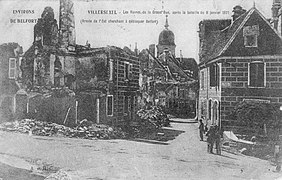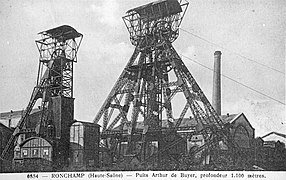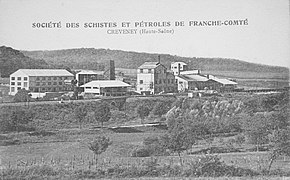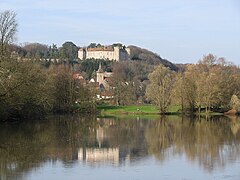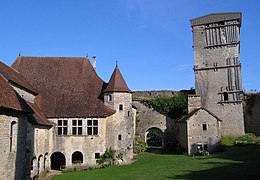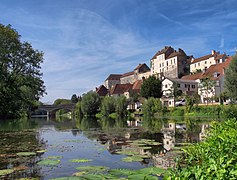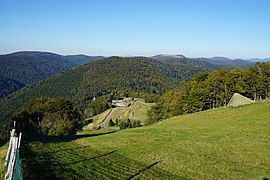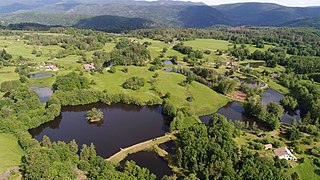Haute Saône
History
The department was created in the early years of the French Revolution through the application of a law dated 22 December 1789, from part of the former province of Franche-Comté. The frontiers of the new department corresponded approximately to those of the old Bailiwick of Amont.
The department was also marked by the Franco-Prussian War with the battles of Héricourt, and Villersexel but also the proximity of the Siege of Belfort. The department welcomes Alsatians fleeing the annexation of Alsace-Lorraine.
- The Franco-Prussian war in Haute-Saône
-
View of the destruction of Bourg de Villersexel
-
German artillery in front of the ruins of castle of Villersexel
The department has an important mining and industrial past (coal, salt, iron, lead-silver-copper mines, bituminous shale, stationery, spinning, weaving, forges, foundries, tileries, mechanical factories).
- Emblematic industries of Haute-Saône
-
Arthur de Buyer Coal Mine (1.010 m) the deepest coal mine in France between 1900 and 1910
-
Gouhenans Saltworks is one of the most important saltworks in France in the 19th century
-
Interior view of the Varigney factory (Dampierre-lès-Conflans), the iron industry was developed until the middle of the 20th century
-
Creveney bituminous shale distillation plant, a rare operation in France between the two world wars
Geography
Haute-Saône is part of the Bourgogne-Franche-Comté region, and is divided into 2 arrondissements and 17 cantons. Neighbouring departments are Côte-d'Or to the west, Haute-Marne to the north-west, Vosges to the north, Territoire de Belfort to the east, Doubs to the south and east and Jura to south. The commune of Champlitte is the largest commune in this department, with an area of 128 km (49 sq mi).
The department can be presented as a transitional territory positioned between several of the more depressed departments of eastern France and the so-called Blue Banana zone characterised, in recent decades by relatively powerful economic growth.
- Landscape
-
Landscape in the southeast
-
Ray-sur-Saône in the west of the department
Economy
The department is overwhelmingly rural, despite the area having been at the forefront of industrialisation in the eighteenth century. The industrial tradition remains, but industrial businesses tend to be on a small scale. In 2006 employment by economic sector was reported as follows:
- * Agriculture 4,919 employees
- * Construction 4,504 employees
- * Industrial sector 18,747 employees
- * Service sector 44,865 employees
Demographics
|
| |||||||||||||||||||||||||||||||||||||||||||||||||||||||||||||||||||||||||||||||||||||||
| ||||||||||||||||||||||||||||||||||||||||||||||||||||||||||||||||||||||||||||||||||||||||
| Sources: | ||||||||||||||||||||||||||||||||||||||||||||||||||||||||||||||||||||||||||||||||||||||||
In common with many rural departments in France, Haute-Saône has experienced a savage reduction in population, from nearly 350,000 in the middle of the nineteenth century to barely 200,000 on the eve of the Second World War, as people migrated to newly industrialising population centres, often outside Metropolitan France.
During the second half of the twentieth century the mass mobility conferred by the surge in automobile ownership permitted some recovery of the population figure to approximately 234,000 in 2004.
Principal towns
The rural nature of the department is highlighted by the absence of large towns and cities. Even the department's capital, Vesoul, still has a population below 20,000. As of 2019, there are 5 communes with more than 5,000 inhabitants:
| Commune | Population (2019) |
|---|---|
| Vesoul | 14,914 |
| Héricourt | 10,646 |
| Lure | 8,046 |
| Luxeuil-les-Bains | 6,623 |
| Gray | 5,553 |
Politics
The president of the Departmental Council is Yves Krattinger, first elected in 2001.
Current National Assembly Representatives
| Constituency | Member | Party | |
|---|---|---|---|
| Haute-Saône's 1st constituency | Barbara Bessot Ballot | La République En Marche! | |
| Haute-Saône's 2nd constituency | Christophe Lejeune | La République En Marche! | |
Tourism
-
Notre-Dame du Haut by Le Corbusier (UNESCO)
-
Landscape of Plateau des Mille Étangs
See also
- County of Burgundy - History
- Franche-Comté
- Cantons of the Haute-Saône department
- Communes of the Haute-Saône department
- Arrondissements of the Haute-Saône department
- Arpitan language
References
- ^ "Répertoire national des élus: les conseillers départementaux". data.gouv.fr, Plateforme ouverte des données publiques françaises (in French). 4 May 2022.
- ^ "Populations de référence 2022" (in French). The National Institute of Statistics and Economic Studies. 19 December 2024.
- ^ Populations légales 2019: 70 Haute-Saône, INSEE
- ^ Agreste Franche Comté : Agriculture
- ^ "Historique de la Haute-Saône". Le SPLAF.
- ^ "Évolution et structure de la population en 2016". INSEE.
- ^ Nationale, Assemblée. "Assemblée nationale ~ Les députés, le vote de la loi, le Parlement français". Assemblée nationale.
External links
- (in French) Prefecture website
- (in French) Departmental Council website Archived 2019-05-07 at the Wayback Machine
- (in French) Tourism website


